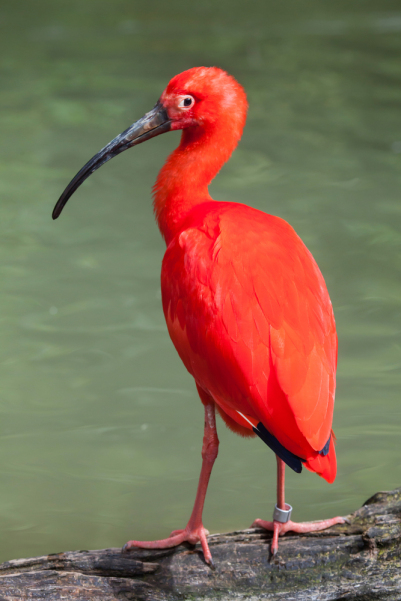
The Scarlet Ibis(Eudocimus ruber) is a wading bird that can be found in the Americas.
Physical Characteristics
During the breeding season the Scarlet Ibis is red throughout most of its body, except its beak, some of its flight feathers, and its eyes are black.
A non-breeding adult is pink or reddish. A juvenile Scarlet Ibis is a mix of gray, brown, and white.
The Scarlet Ibis has a long, narrow, decurved bill.
| Length | 56-71 cm(1’10.1”-2’3.10”) |
| Wingspan | 94 cm-1.1 m(3’1”-3’7.3”) |
| Weight | 505-770 gm(1.11-1.7 lbs.) |
Range
The Scarlet Ibis is a year round resident in the countries of; Brazil, Colombia, French Guiana, Guyana, Suriname, Trinidad and Tobago, and Venezuela.
Scarlet Ibises can also be seen in Aruba, Belize, Cuba, Dominica, Ecuador, Grenada, Panama, and the United States.
Habitat
The Scarlet Ibis inhabits swamps, mangroves, estuaries, mudflats, freshwater marshes, shallow lakes, sewage ponds, lagoons, fish ponds, and rice paddies.
Breeding
Scarlet Ibises nest in large breeding colonies, often with other ibises and herons. The nest is a platform of sticks that is placed in a tree. The clutch size is 1 to 3 eggs. The incubation period is 21 to 23 days.
Diet
Scarlet Ibises eat crustaceans, snails, insects, and small fish.
Predators
Predators of the Scarlet Ibis include raccoons, snakes and big cats.
Conservation Status
The Scarlet Ibis is listed as least concern.
Fun Facts
- a heavy diet of red crustaceans produces the Scarlet Ibis’s coloration.
- The Scarlet Ibis can live for up to 20 years.
